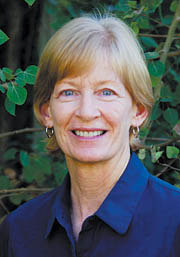 I remember the first time I heard the wild call of a northern flicker. The sound was so loud and raucous, I thought an exotic bird had escaped from the Cheyenne Mountain Zoo. Upon seeing the bird and studying it with my binoculars, I observed a large woodpecker with a dalmatian-like pattern of black spots on its
white breast, a black crescent under its neck and bright orange tail feathers. With such distinct colors and markings, it was easy to identify the bird as a northern red-shafted flicker.
I remember the first time I heard the wild call of a northern flicker. The sound was so loud and raucous, I thought an exotic bird had escaped from the Cheyenne Mountain Zoo. Upon seeing the bird and studying it with my binoculars, I observed a large woodpecker with a dalmatian-like pattern of black spots on its
white breast, a black crescent under its neck and bright orange tail feathers. With such distinct colors and markings, it was easy to identify the bird as a northern red-shafted flicker.
 A flicker is a type of woodpecker. Les Goss photo
|
Even though the flicker's call - "wicka-wicka-wicka" - is its spring territorial call, I almost always hear a flicker sing a few "wicka" notes during late January and February. This year on Feb. 22, I also heard the flicker drumming (pecking rapidly) in preparation for spring. Usually in April, the male and female flickers begin their courtship communication in earnest, drumming to each other to establish their relationship and nesting territory.
A flicker often discovers that its drumming will be even louder if it pecks on metal house chimneys and gutters. This habit definitely increases the range of the flicker's communication, but is not always appreciated by the homeowner! A loud handclap will usually frighten the noisy bird away.
A flicker spends a lot of time on the ground in search of insects, as almost 50 percent of its diet is ants. It uses its long beak to dig and probe for ants, sometimes digging such a deep hole that its entire head "disappears" into the ground.
A walk through almost any Westside park or neighborhood will also be through a flicker's territory. In spring and early summer, listen for its spirited call; and year-round, watch for the flash of its red-orange feathers.
Walker, a long-time area naturalist, posts regular entries in her online blog at naturenarratives.com. She has given her permission to reprint selected pieces in the Westside Pioneer.